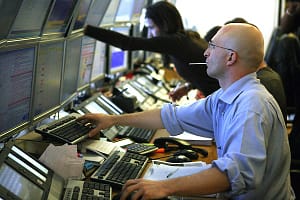Markets opened Monday with positive momentum in Wall Street futures, providing a psychological boost to global markets after reports of a “significant breakthrough” in trade talks between the United States and China.
I believe the surge in Dow Jones, S&P 500, and Nasdaq futures reflects not just an immediate reaction to the news but also investors’ deep thirst for any positive signals that might ease a prolonged trade war that has weighed heavily on global growth.
However, this wave of optimism must be interpreted within a broader context of mounting uncertainties, particularly given the lack of concrete details about the nature of this so-called “progress.”
In reality, what happened over the weekend in Geneva between U.S. and Chinese negotiators, while described as “productive,” lacked any clear commitments or tangible mutual concessions.
Financial markets are inherently sensitive to positive tone shifts, which explains the immediate spike in futures.
Yet, this upswing may prove short-lived if not followed by actual policy measures on the ground. I believe optimism alone cannot shift economic trajectories shaped by deeper realities such as high inflation, tight monetary policies, and stagnation in global trade.
Supporting this view is the fact that all three major Wall Street indices ended last week in decline, indicating fragile investor confidence. Thus, the current rebound does not signify the beginning of a sustained rally but rather a temporary pause in a volatile path dictated more by breaking news and political statements than by solid economic fundamentals.
With tariffs still in place, markets remain vulnerable to further inflationary pressures—something that this week’s Consumer Price Index (CPI) report is likely to reveal. In this context, comments from U.S. Commerce Secretary Howard Lutnick reaffirm the ongoing escalation in trade policy, as he insists on a baseline tariff of 10% on all imports. In my view, this weakens the credibility of any talk about de-escalation and raises doubts about Washington’s seriousness in easing trade tensions, especially at a time when the country is experiencing the highest inflation expectations in over four decades.
China’s retaliatory tariffs of 125% are equally aggressive, reinforcing the notion that this is more of a “game of chicken” than a negotiation conducted in good faith.
The economic consequences of these policies are far from theoretical—they are already being felt through rising consumer costs and increased production expenses for businesses. That’s why the release of CPI and retail sales data this week will serve as a true test for the short-lived wave of optimism currently gripping the markets. If these figures show higher prices and a slowdown in demand, markets are likely to fall again, driven by the realisation that the bigger threat lies not in political rhetoric, but in actual economic conditions.
Moreover, movements in the U.S. dollar and the sell-off in Treasury bonds suggest that investors are reassessing their expectations around interest rate cuts. The current probability of a rate cut in June stands at just 17%, rising only slightly in July. This implies that markets are starting to understand that inflation may force the Federal Reserve to maintain tight monetary policy for longer. This shift in sentiment highlights growing awareness that any trade talk progress, if not accompanied by real price declines and economic stabilisation, won’t be enough to alter monetary policy or improve market sentiment in the medium term.
Interestingly, investors now seem to have greater confidence in statements from Beijing than from the White House—a rare development in global markets. This isn’t solely due to America’s aggressive trade stance, but also because of the conflicting and often self-defeating messages coming out of Washington. Such inconsistency creates an unstable investment environment and pushes markets to trust whichever side appears more stable and rational, even if that’s an authoritarian system.
As for the trade talks themselves, while described as “productive,” the absence of specifics raises doubts. Asian analysts have noted that any real progress must include mechanisms for regular dialogue or tangible tariff reductions to gain credibility. In this light, I see the alleged agreement between Washington and Beijing, while symbolically important, as still far from being a true turning point in their economic relations—unless it translates into measurable, practical actions.
In conclusion, I believe markets currently stand between the hammer of political optimism and the anvil of economic reality. The short-lived spikes in futures reflect a momentary wave of positive anticipation, but they won’t endure unless actual policy shifts occur and trade relations are reset on more realistic foundations. Until then, investors should prepare for continued volatility and base their risk assessments on data, not declarations.





Leave a Comment